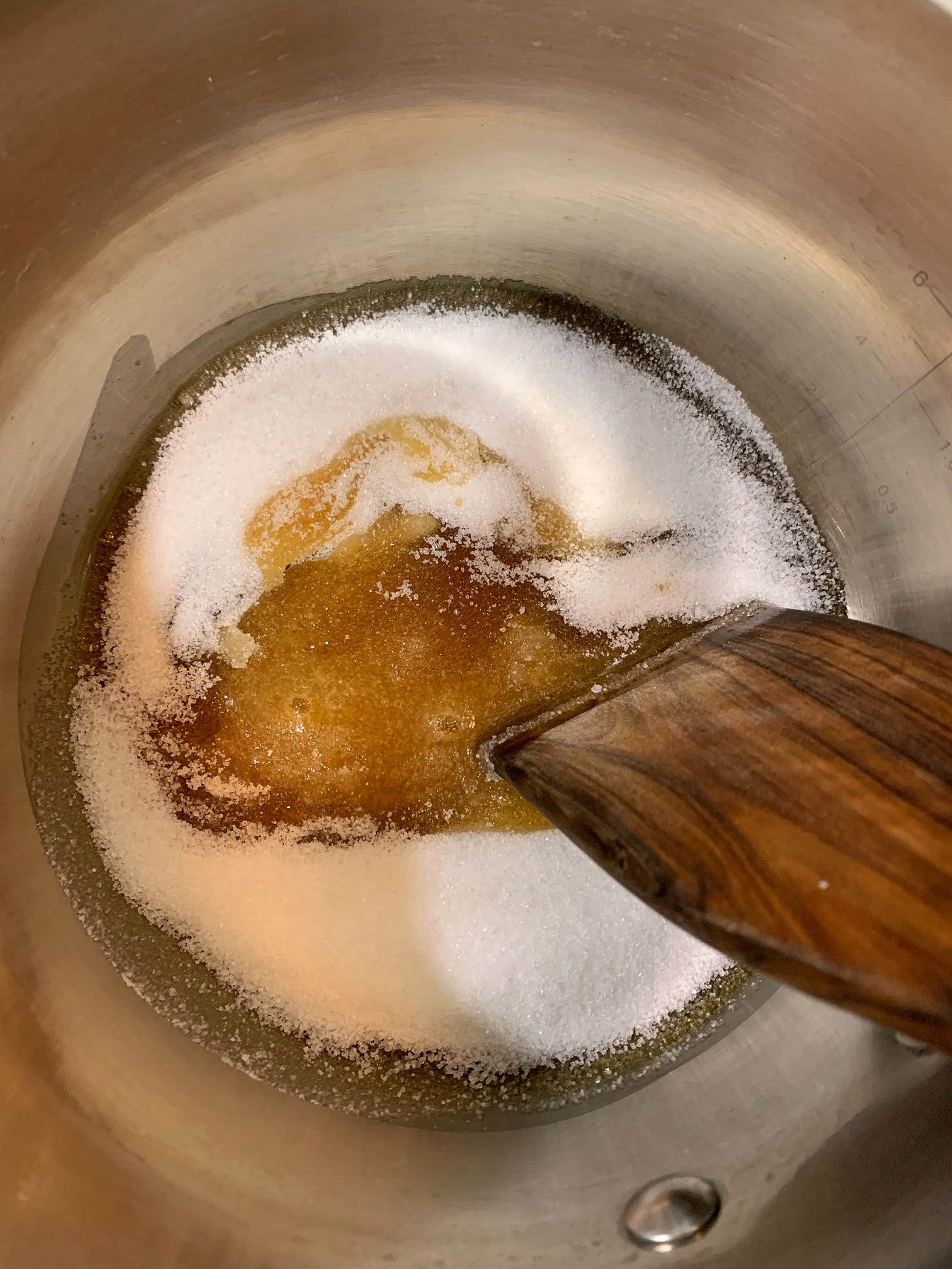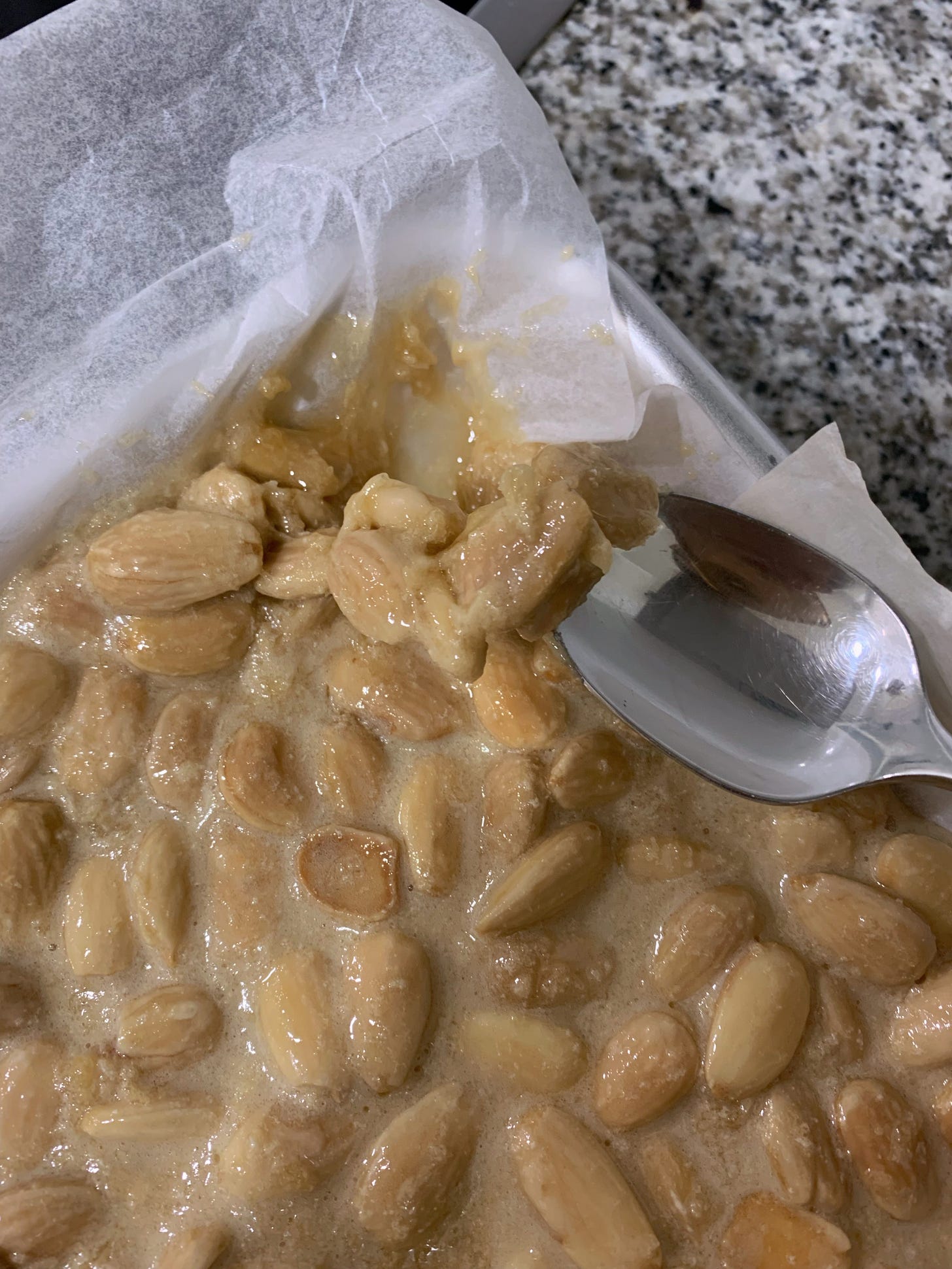There was an attempt: to make turrón (aka nougat)
Defining the Spanish Christmas treat, embracing chaotic kitchen energy, and notes on a failed recipe
If peppermint is considered the holiday icon of the US, the Spanish equivalent would be almonds. Come December, shelves are lined with almendra1-studded treats: marzipan figures, polvorones, and my personal favorite—turrón.
Turrón is the Spanish word for nougat, which I actually didn’t realize until several years after I first tried the candy. My previous experience with nougat was rooted in Milky Way bars, which are described on the company’s website as being “made with creamy caramel and smooth nougat, enrobed in rich milk chocolate.” Don’t be fooled, though; Milky Way nougat is nothing like the nougat you’ll find in Spanish storefronts.
These days there are many, many varieties of turrón, but historically there are three main types. My personal favorite is called turrón de Alicante or turrón duro (hard nougat). It consists of honey, sugar, and egg white that are cooked together and mixed with whole almonds, resulting in a hard candy similar to peanut brittle. The second kind is called turrón de Jijona or turrón blando (soft nougat). This one has the same ingredients, but everything is blended and the final result is a sweet paste. The last is called turrón de yema tostada. This variety is different than the other two in that it has egg yolk instead of egg white. It also has condensed milk or cream. The texture is similar to turrón blando, except…squishier. Can you tell it’s my least favorite?2
You can find turrón year-round (I often buy it for my family when I go home to visit at a little shop in the center of the city called El Riojano), but its time to shine is during Navidades.3 That’s when puestos de turrón4 start popping up in plazas, and a dedicated counter appears in the middle of El Cortés Ingles5 to tempt the masses with the almond-y treats.
Being surrounded by the confection, I naturally had to write about turrón for Come como Kiki. I guess I could have gone into the history of turrón, or done a taste test of all the modern flavors, or rounded up the best brands in Madrid. But instead I decided to try to make it at home.

When I want to make a recipe, I typically do quite a bit of research, looking for versions on long-trusted food blogs or in cookbooks. A baker at heart, I love recipes with specifics. A recipe writer will win me over by telling me the exact amount of the ingredient I need (what constitutes a large potato vs a medium one, anyway?). Measuring the internal temperature of animal protein is the only way I feel safe cooking it. And I keep detailed notes on baking recipes I’ve made to remind myself of at what exact minute I need to raise or lower the sheet pan to golden the cookies just so.
This time around I decided to try something different. What if I were to just choose a random recipe, follow it, and see what transpires? Granted, making this decision when attempting a candy recipe was probably not the best idea, but I figured it would represent more of a real-world approach to finding a recipe. Who has time to scour the internet looking for the perfect turrón technique?
And so I began.
The recipe I chose called for raw Marcona almonds, honey, granulated sugar, and egg white. It also called for something called oblea, which is a thin edible paper that covers both sides of turrón duro. I skipped the oblea because a) it’s not entirely necessary, and b) buying a package when I was only planning on using one or two sheets seemed like a waste.
Once I was home with my ingredients, I wisely read all the way through the recipe before beginning. I decided to switch the order of steps around a bit (even a turrón novice like myself assumed that this was a fast-moving recipe, so any toasting or beating should be done beforehand), but even that wasn’t enough to avoid the impending disaster.
First, I toasted the almonds in the oven for about 7 minutes at 175°C/350°F, stirring once about halfway through. If you’ve never toasted your own nuts at home, I recommend trying it sometime—it’s easier than you think, and it makes your kitchen smell amazing. You just have to be on standby to make sure you don’t burn them, because they can go from golden to scorched fairly quickly.
Next, I decided to tackle the egg white. I started out attempting this by hand, before I looked up what bien espesas meant in relation to egg whites. I found nothing helpful (it basically means “well-thickened”) so decided to Google clara de huevo turrón (egg white turrón) to see if that yielded more success. I learned two things: 1. A punto de turrón is actually the name for a stage of egg whites (its English equivalent is soft peaks), and 2. I was not going to achieve that stage by hand any time soon. I felt committed to using that particular bowl instead of moving the egg white to our KitchenAid stand mixer, so in a stroke of genius (or of pereza6) I decided to use our cheap milk frother from Ikea. This worked surprisingly well (although it still took a while, but at least my wrist wasn’t hurting after), and I set the egg white aside to focus on the honey.
As stated in the recipe, I heated the honey until it was liquid (or at least liquid-y) and then tipped in the pre-measured sugar. I started cooking the mixture over low heat, stirring constantly. The sugar didn’t seem to be dissolving, so I slowly turned up the heat, notch by notch, until I landed on medium-low heat. They say a watched pot never boils, but I think there should be another idiom that says azúcar vigilado nunca funde (watched sugar never melts).
Let me interject to admit that at this point, I knew this little project was on its way to failure. I was going off of a recipe that really didn’t give me many clues at all as to what things should look like or any little tricks to know that I was on the right path. I could have decided to abandon the project (or troubleshoot by looking up candy temperatures or how to do the cold water test), but I decided to really lean in and go for it instead. There was something exciting about embracing that chaotic kitchen energy and well, screwing something up. There aren’t many low-stakes opportunities that present themselves in our adult lives to just make a mistake without any consequences. Why not have some fun?
Eventually, the sugar did melt and the mixture was more homogenous, so it was time for the egg white. I pulled the almonds from the oven (I had put the tray back in with the oven off to keep them warm) to have them handy, and grabbed my soft peaks of egg whites that had been waiting for me. After pouring in the whites, I began to beat the mixture rapidly with a wooden spatula, until the whites were melted into the honey-sugar syrup. I immediately added in the almonds, stirred well, and poured the molten turrón into my pre-prepped mold (see picture at top of post). Now it was time to wait.
I checked the block of turrón throughout the day and while it hardened somewhat, the top layer continued to be sticky. I decided to leave the candy overnight just in case, but with the expectation that when I woke up in the morning it was not likely to be any more duro.7
The next day I woke up and headed to the kitchen. I lightly touched the candy with my finger, and yep—still tacky. An attempt to pull out a piece with a knife confirmed my suspicions: I had made a new invention of turrón taffy. Potentially delicious, but not exactly the effect I was looking for.
The next best thing I could think of was to pop the tablet into the freezer. I checked it after an hour or so, and as expected, it did harden. However, it still didn’t have that brittle texture that characterizes turrón duro. After taking a bite, it didn’t have the correct flavor, either—it leaned a bit too honey-flavored compared to the typical turrón that you would find in a store.
So why post about a flopped recipe? Why even make something when you’re pretty sure you’ve been set up for failure in the first place? Various reasons, actually:
As I mentioned before, most people don’t have the time or energy to seek out the perfect recipe when they want to try something new. Years ago, people searched through the cookbooks on their shelves or maybe a rolodex of family favorites, but now with the internet the world is at our fingertips, including millions of recipes. How do you even choose which is the best?
We personally have an insane amount of kitchen gadgets, but I would bet the average cook (at least in the US) doesn’t have a digital candy thermometer. I remember when I was younger and my mom and grandmother would make homemade fudge for Christmas, they relied on a wing and a prayer that the candy would harden. Some years we had perfect little squares on a platter, and others we scooped it out of the glass pan by the spoonful. No one was mad at the second scenario.
With the rise of more science-based cooking due to the popularity of chefs like Kenji López-Alt, there has come somewhat of a backlash. I’ve read people complain that cooking isn’t supposed to be about finding a formula for achieving the perfect Maillard reaction for chocolate chip cookies, it should be about instinct and feel. While this may work for something like a soup, some things really do come down to science. If I were actually invested in making high-quality turrón, I would have sought out a recipe that gave temperatures for hardening candy and called for a sugar thermometer. Which brings me to my final point…
Not all things are worth making at home. In a recent article I read, someone mentioned the book Make the Bread, Buy the Butter. While I haven’t read the book, the synopsis is one I can identify with: homemade foods don’t always vale la pena.8 Sure, it's fun to experiment with recipes at home (I rather enjoyed my horchata casera this past summer!), but there's nothing wrong with buying something pre-made, either. There's so much societal pressure to make your own preservative-free, grain-free, natural-sugar-only concoction of whatever conventional treat. Let's give ourselves a break! Sometimes you just want to buy the candy at the store and go on with your day.9
So will I attempt to remake the turrón? Quizás.10 But I also know that perfectly crunchy, almond-filled goodness is waiting for me a three minute walk away, and who can say no to that?
What type of cook are you: science-based or cook-by-feel? How do you decide a recipe is worth making? Excited to hear from you in the comments!
See you next week!
Ki
Almendra: Almond
On the yema tostada variety: I’m lucky that my least favorite is the only one I can’t eat anymore after finding out about my milk intolerance!
Navidades: Christmastime
Puestos de turrón: Nougat stands
El Cortés Ingles: The major grocery/department store chain in Spain
Pereza: Laziness
Duro: Hard
Valer la pena: To be worth the effort
On buying store-made treats instead of making them at home: This of course doesn’t apply to people with allergies/dietary restrictions that have to make modified versions.
Quizás: Perhaps






